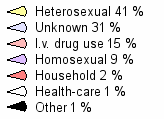|
|
|
|
|
|
Hepatitis B Virus (HBV)
(cross-section)
|
|
|
|
|
|
|

|
|
Hepatitis B transmission
in the U.S.
|
|
Form of infectious contact
|
|

|
|
Based on cases 1992 - 1993. Source: CDC, USA
|
|
|
|
|
|
1. What is it?
Hepatitis (from gr. hepatos: liver) is an inflammation of the liver caused, in this case, by the Hepatitis B Virus (HBV). It can create short-term problems (acute hepatitis) and, in some cases, a chronic condition (chronic hepatitis). The “B” in its name stands for “Blood” and dates back to the time when doctors first realized that the virus was transmitted through blood transfusions. However, today this danger is very remote in modern societies, because all blood donations are screened. In the meantime, we know that blood is not the only vehicle to transmit this particular virus, and that other viruses causing hepatitis can also be present in blood.
2. What causes it?
The disease is caused by the Hepatitis B Virus (HBV). It is much more contagious than the Human Immunodeficiency Virus (HIV). However, generally speaking, it causes much less damage, because many infected people have no symptoms. Those that do get sick often have only temporary symptoms and soon feel well again. In some patients the disease becomes chronic, and a minority of these may develop very serious health problems.
3. How is it transmitted?
Hepatitis B is transmitted through body fluids like blood, semen, and vaginal secretions. The virus has also been found in saliva, tears, and mother’s milk. Even a very small cut or abrasion in the skin can make it possible for the virus to enter the body. Sexual contact is one obvious way of transmission, another is the sharing of needles among intravenous drug users. Still another is tattooing and piercing with an infected instrument. Even shaving with an infected razor blade can lead to infection. Living with a household member who is infected carries a risk, because the virus can survive outside the body for a few days. Doctors and nurses can get infected by accidentally sticking themselves with a needle containing infected blood. An infected mother can also transmit the virus to her baby during or shortly after birth.
|